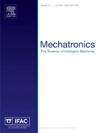使用端口哈密顿框架的卷曲HASEL致动器动态建模与实验验证
IF 3.1
3区 计算机科学
Q2 AUTOMATION & CONTROL SYSTEMS
引用次数: 0
摘要
本文讨论了使用端口哈密顿(PH)框架的卷曲液压放大自愈静电(HASEL)致动器的建模,参数识别和验证。采用模块化方法,HASEL执行器被概念化为基本子系统的组合。每个子系统包括电气和机械组件。该电气元件的特征是与电阻支路并联的可变电容器,该可变电容器与另一个也与电阻支路并联的电容器串联,表示电荷保留相关的漂移。机械部件由连接到等效质量的线性和扭转弹簧组成。采用Levenberg-Marquardt优化算法对模型的参数进行了辨识。另外一组实验数据被用来验证得到的模型。本文章由计算机程序翻译,如有差异,请以英文原文为准。
Dynamic modeling of a curling HASEL actuator using the port Hamiltonian framework with experimental validation
This paper addresses the modeling, parameter identification, and validation of curling Hydraulically Amplified Self-healing Electrostatic (HASEL) actuators using the port Hamiltonian (PH) framework. Employing a modular approach, the HASEL actuator is conceptualized as a combination of elementary subsystems. Each subsystem includes electrical and mechanical components. The electrical component is characterized by a variable capacitor in parallel with a resistor branch, which is in series with another capacitor that is also in parallel with a resistor branch, representing charge retention-related drift. The mechanical component consists of linear and torsional springs connected to an equivalent mass. The parameters of the proposed model were identified using the Levenberg–Marquardt optimization algorithm with data from the developed experimental setup. Additional sets of experimental data were used to validate the obtained model.
求助全文
通过发布文献求助,成功后即可免费获取论文全文。
去求助
来源期刊

Mechatronics
工程技术-工程:电子与电气
CiteScore
5.90
自引率
9.10%
发文量
0
审稿时长
109 days
期刊介绍:
Mechatronics is the synergistic combination of precision mechanical engineering, electronic control and systems thinking in the design of products and manufacturing processes. It relates to the design of systems, devices and products aimed at achieving an optimal balance between basic mechanical structure and its overall control. The purpose of this journal is to provide rapid publication of topical papers featuring practical developments in mechatronics. It will cover a wide range of application areas including consumer product design, instrumentation, manufacturing methods, computer integration and process and device control, and will attract a readership from across the industrial and academic research spectrum. Particular importance will be attached to aspects of innovation in mechatronics design philosophy which illustrate the benefits obtainable by an a priori integration of functionality with embedded microprocessor control. A major item will be the design of machines, devices and systems possessing a degree of computer based intelligence. The journal seeks to publish research progress in this field with an emphasis on the applied rather than the theoretical. It will also serve the dual role of bringing greater recognition to this important area of engineering.
 求助内容:
求助内容: 应助结果提醒方式:
应助结果提醒方式:


